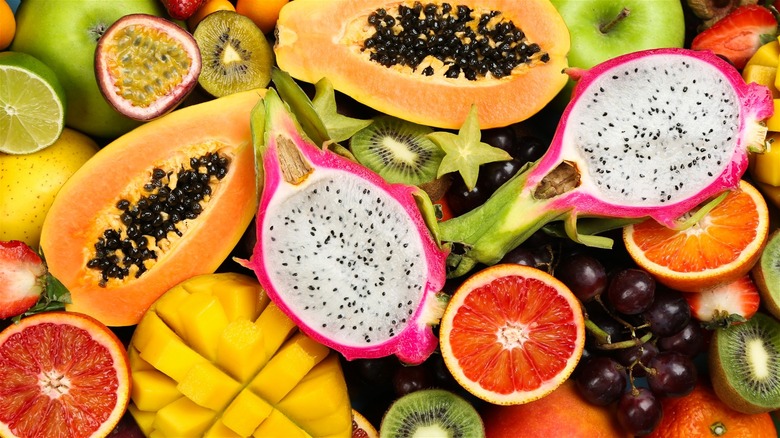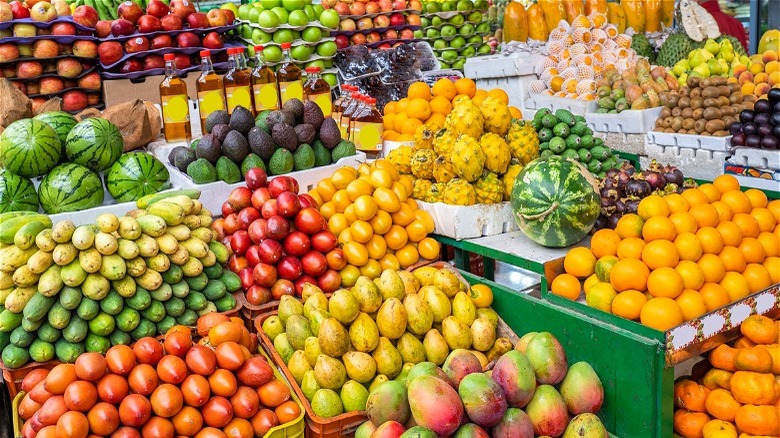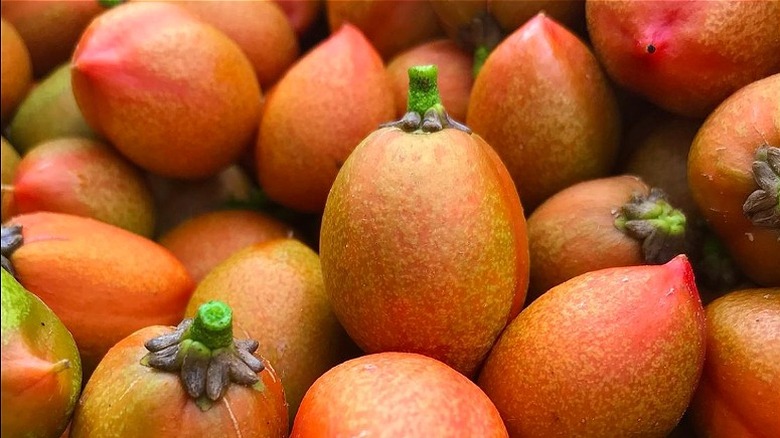The South American Fruit That Tastes Exactly Like Peanut Butter
BananaLink states there are more than 1,000 varieties of bananas worldwide, so it's safe to assume there's a vast array of fruits to learn about aside from the standard apple and orange assortments that line grocery entryways across America. Some of the more uncommon fruits stand by their names: If you ever wondered why cotton candy grapes became so popular, its name speaks for itself. With 12% more sugar than an average grape, the one-of-a-kind variety truly tastes like cotton candy (via NPR). Speaking of fruits that link name to taste, according to Parade, breadfruit, which is a spiky green fruit common in southeast Asia, actually tastes like baked bread.
However, some fruits around the globe don't blatantly reveal their unique flavors by name. Black sapote, which is native to Central America, has the reputation of being compared to chocolate pudding in taste and texture, yet The Guardian notes hints of honey and caramel. Healthline claims the prickly durian fruit grown in southeast Asia has a number of health benefits with unexpected flavors akin to caramel, garlic, and cheese. There is quite an assortment of unexpected and colorful fruits around the world. When considering exotic fruits, look to no other part of the globe than South America to excite your senses.
The exotic fruits of South America
According to a congressional report by an agricultural policy specialist Renée Johnson, six of the top 15 countries that supply fruit and vegetable varieties to the United States are South American (via Progressive Grocer). While many Americans are familiar with the superfood craze over avocados and açaí berries, which The Nature Conservatory attributes to Brazilian ancestry, there are a number of exotic fruits that rarely grace the mouths of individuals outside the South American continent.
Lulo fruit, also known as naranjilla or "small orange," is described by the Slow Food Foundation for Biodiversity as bright yellow or orange on the outside with dark green pulp in its center, similar to a tomato's insides. The fruit is primarily used in condiments and sauces because of its mildly sweet flavor, which tastes nothing like an orange.
While Cleveland Clinic claims soursop or guanabana has many health benefits due to the fruit's fiber, magnesium, and vitamin C boosts, The New York Times describes soursop's flavor as the "platonic ideal of tropical fruit: a beguiling combination of citrus, banana, pineapple, strawberry, and papaya" with a satisfying pull-apart texture.
Apart from lulos and soursops, South America produces many other fruits that taste like fruit salad mashups such as feijoas which The American Indian Health and Diet Project describe as a flavor intersection between strawberry, pineapple, and guava with a hint of mint. Among these sweet blended flavor variants, one South American fruit stands apart for its unique taste.
The one South American fruit that tastes like peanut butter
Peanut butter fruit, also known as bunchosia argentea or ciruela del monte, are bright red elongated fruits grown on 10- to 15-foot trees primarily in Brazil and are mostly known for an astonishingly nutty flavor (per TopTropicals.com). Gastro Obscura describes the taste beyond peanut butter to include "hints of sweet potatoes and berries." While the fruit is commonly eaten raw, Specialty Produce states peanut butter fruit is often blended into milkshakes and cooked into pastries. Unfortunately, this incredibly unique fruit is not commercially marketable due to its fragility during shipping (per Specialty Produce).
On a health-related note, lycopene is a nutrient found in specific plants and has significant antioxidants that can increase heart health and potentially lower the risk of some cancers (per Healthline). One 2013 study measured the nutrients of peanut butter fruit to find significant amounts of lycopene within its flesh –- almost 10 times more than an average tomato. The Brazilian-based study gives hope to its male inhabitants since prostate cancer is the second most prevalent in the country. If more men consume peanut butter fruit, they are indirectly lowering their risk of cancer.
Peanut butter fruit has both health-enhancing properties and a truly surprising taste, yet it doesn't stand alone in its nutty flavor. The mamey sapote, often grown in Mexico, South America, and southern parts of the U.S., are also reddish oblong fruits that have a flavor the University of Flordia describes as similar to an almond.


